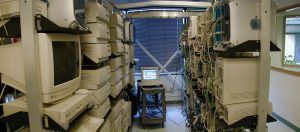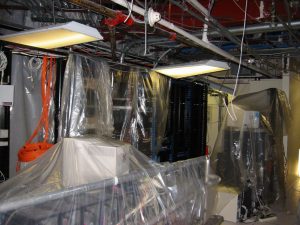Outdated and In Trouble: Monitoring Aging Infrastructure
 It’s an issue that facility managers have always dealt with—what was once a gleaming new business is now starting to show its age….and the problems that go along with it. Those that have the resources can move onto the next new manufacturing plant or warehouse, but more often than not, a variety of staff will have to work together to address the challenging task of maintaining operational uptime at their current location.
It’s an issue that facility managers have always dealt with—what was once a gleaming new business is now starting to show its age….and the problems that go along with it. Those that have the resources can move onto the next new manufacturing plant or warehouse, but more often than not, a variety of staff will have to work together to address the challenging task of maintaining operational uptime at their current location.
When working with dated infrastructure, whether in a large factory full of mechanical equipment, critical data center running sensitive electronic components, or simple IT equipment room in a college, hospital, or business, one of the key factors in avoiding downtime is the employment of monitoring solutions. After all, it’s much easier, safer, and cost-effective to identify and address a problem at its onset than to fix the damage once it’s too late.
First, you have to know where to look
The question remains: “What threats should I be looking for in my facility?” Whether in a new or old building, the answer is the same—environmental factors that threaten the safety of IT or mechanical equipment. Leak detection and environmental monitoring solutions are the two most important tools that facility managers can utilize to avoid downtime at their businesses, especially as equipment grows older and is more prone to failure.
Watch out for water
 Fluid intrusion (water especially) is one of the greatest threats to dated infrastructure as liquid can be found in any number of places that will fail with age and overuse: uncapped sprinkler lines, improperly monitored A/C units, clogged drains, faulty construction (leaky roofs and improperly installed windows), frozen pipes, etc. The good news is that there are also a variety of solutions with ease of installation to help mitigate these problems.
Fluid intrusion (water especially) is one of the greatest threats to dated infrastructure as liquid can be found in any number of places that will fail with age and overuse: uncapped sprinkler lines, improperly monitored A/C units, clogged drains, faulty construction (leaky roofs and improperly installed windows), frozen pipes, etc. The good news is that there are also a variety of solutions with ease of installation to help mitigate these problems.
We find that leak detection cabling and spot detectors tied into a Building Management System (BMS) can alleviate most threats if installed properly. For instance:
- Running leak detection cable or spot detectors around equipment that may exude conductive fluids will cause the associated monitoring unit to quickly notify facilities if a breach has occurred.
- Placing leak detection cable connected to a distance read controller around the perimeter of sensitive areas will alert staff when there is a structural leak the moment it has begun. This has the added bonus of pinpointing exactly where a leak is so that the issue can be fixed before more damage occurs.
- Zip tying leak detection cable to the bottom of overhead pipes will cause the smallest amount of water to be detected before the problem gets out of hand.
Discover a delta before it becomes a disaster
That environmental threats pose significant risks to facilities is clear, and the potential for this type of problem only increases with a facility’s age. As with leaks, there are a variety of other environmental issues that need to be monitored: temperature and humidity going out of spec, changes in pressure, smoke, etc. Left unchecked, any of these problems can bring even the most well-run facility to a standstill. Environmental monitoring technology is critically important in this context due to the pinpoint information it provides to notify of a problem at its onset.
 As mentioned above, environmental monitoring can take many forms, but for this example we’ll consider temperature. A rise in temperature can mean a variety of problems to a facility with dated infrastructure: overheating machines, problems with cooling equipment, leaks in cooling lines, or maybe the facility is finally running at maximum capacity and you discover that the infrastructure just can’t handle the cooling load. Noticing a general increase in temperature will alert facility managers that something is amiss, but environmental monitoring solutions help to prevent problems in the first place. When it comes to temperature, a simple wired or wireless sensor tied into a BMS and placed next to sensitive equipment will indicate when a critical piece of equipment is generating too much heat and needs to have its load shunted elsewhere.
As mentioned above, environmental monitoring can take many forms, but for this example we’ll consider temperature. A rise in temperature can mean a variety of problems to a facility with dated infrastructure: overheating machines, problems with cooling equipment, leaks in cooling lines, or maybe the facility is finally running at maximum capacity and you discover that the infrastructure just can’t handle the cooling load. Noticing a general increase in temperature will alert facility managers that something is amiss, but environmental monitoring solutions help to prevent problems in the first place. When it comes to temperature, a simple wired or wireless sensor tied into a BMS and placed next to sensitive equipment will indicate when a critical piece of equipment is generating too much heat and needs to have its load shunted elsewhere.
When a facility has dated infrastructure, the likelihood of downtime-inducing problems only increases with time. The ability to make improvements and corrections based on the early detection of environmental threats is the best solution. Retrofitting older facilities with robust leak detection and environmental monitoring tools ensures that a minor upfront investment will yield lasting benefits, helping to keep critical businesses running better and for longer.
Leave a Reply
